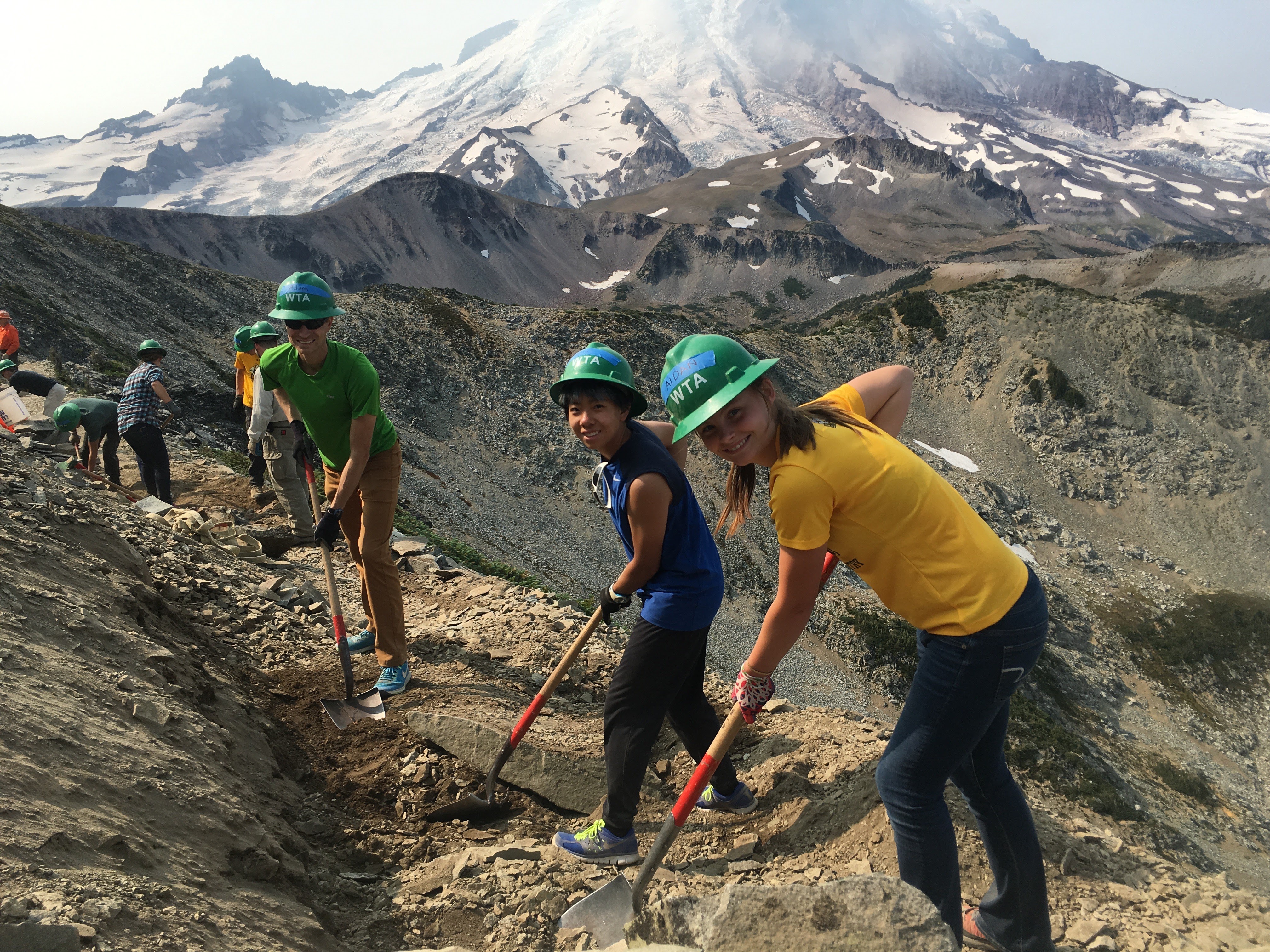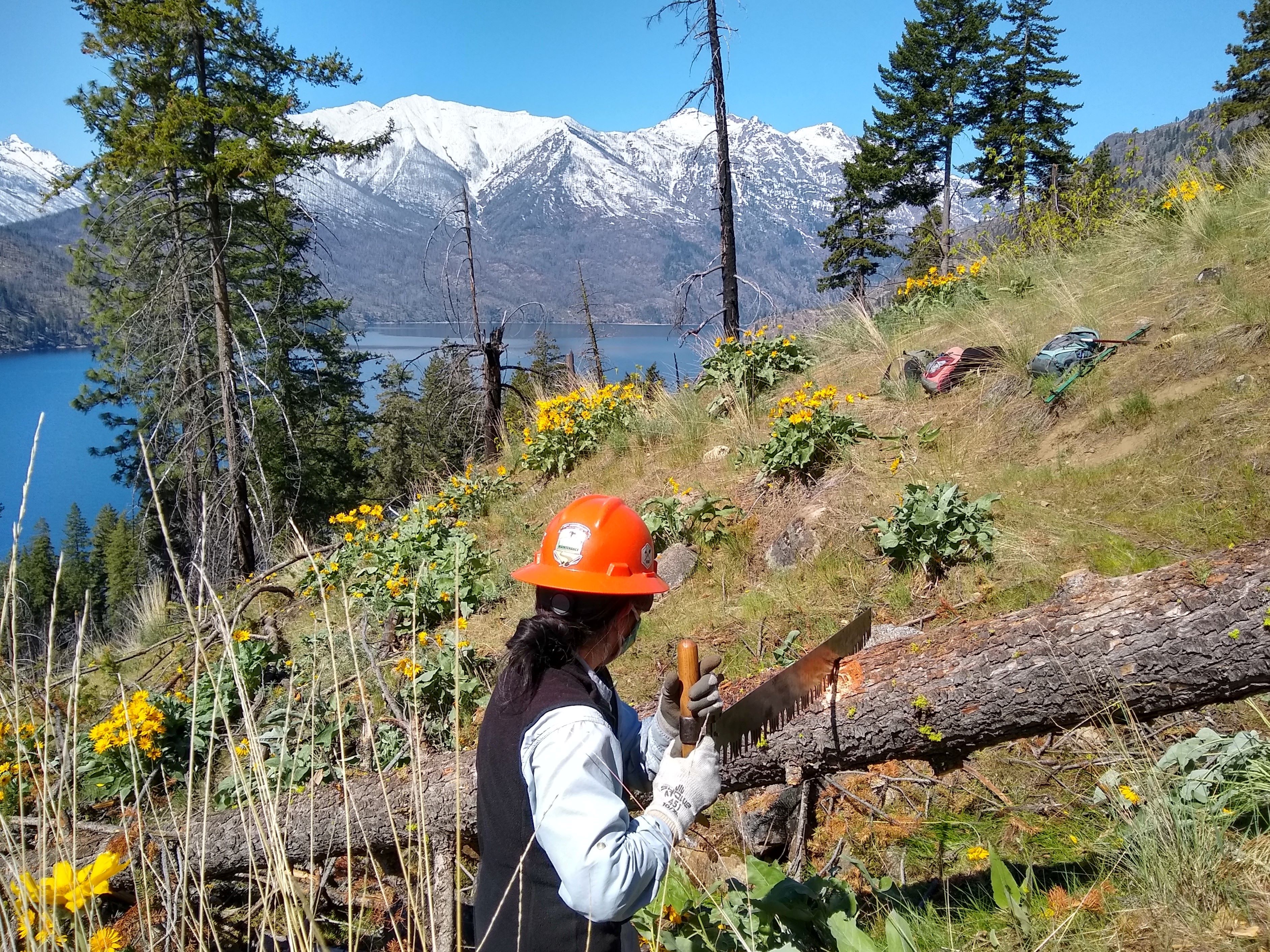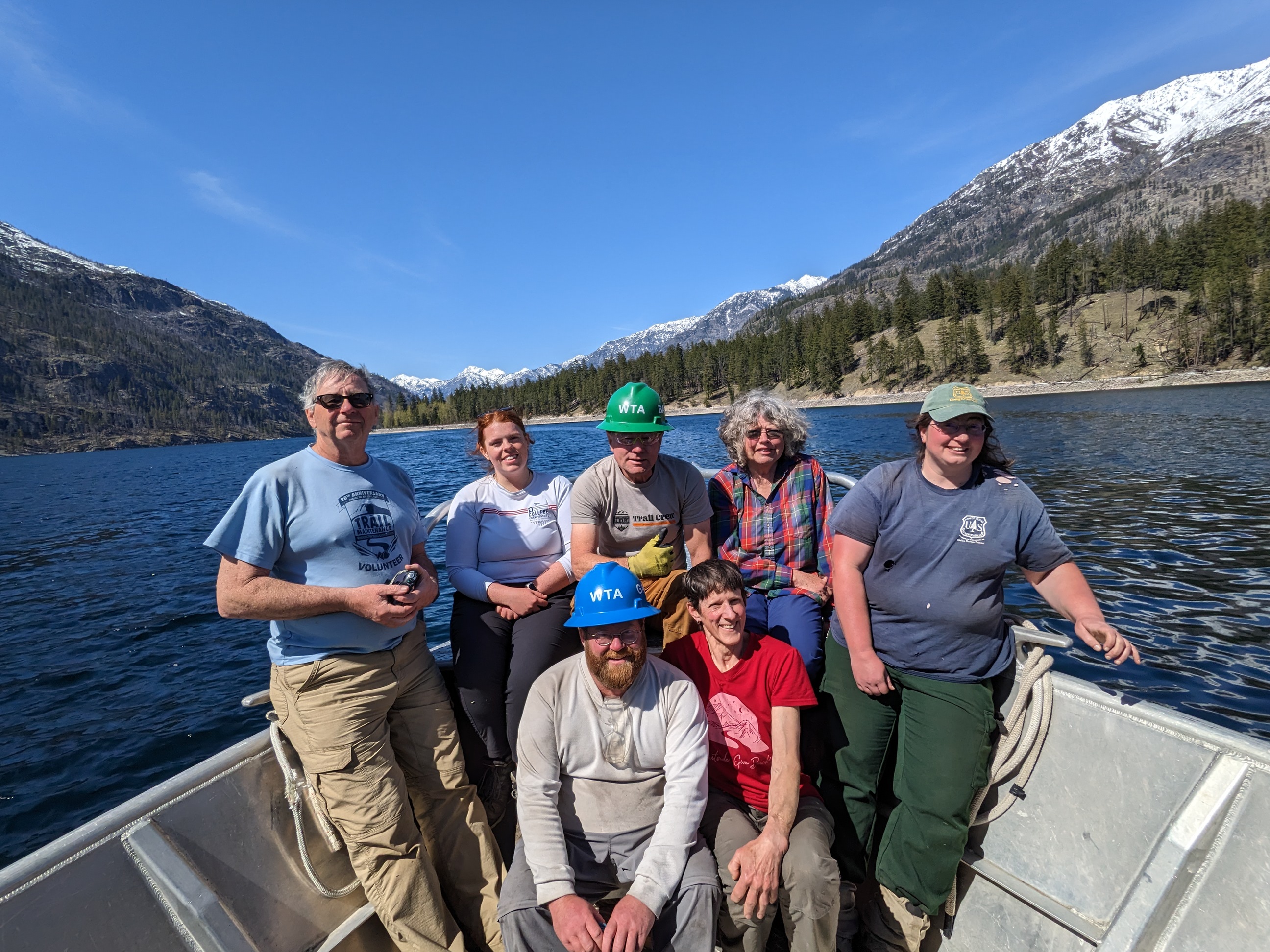The Power of Annual Trail Maintenance
WTA's Claire Thompson reflects on why the less-glamorous tasks of annual trail maintenance are some of the most important, cost-effective and impactful trail work we do.
by Claire Thompson
When I first started doing trail work — exactly ten summers ago now — I remember the excitement I felt when my conservation corps crew was tasked with constructing a significant reroute of a trail in southern Colorado’s La Garita Wilderness.
Up to that point, we’d been clearing trail corridor of brush and fallen trees and cleaning drains, which funnel water off trail. It was necessary but uninspiring to me, and I was stoked to dig into what felt like a more technically challenging and materially satisfying project: a whole new trail, built just by us! Something, where before there was nothing.

Projects like WTA's work at Sunrise in 2018 built some structures on the trail that leads to Fremont Lookout. New trail or complex projects can be rewarding work, as Claire learned in her early days of trail work. Photo by Hannah Tennent.
As we built this brand-new trail, I learned about backslope, hinge, outslope and critical edge. I was fascinated by theories of sustainable trail design. We were working in steep, rocky terrain, and I learned first-hand about the sheer physical labor and technical expertise required to build just a few feet of ideal trail.
There's gratification in creating something new that will be enjoyed by generations to come. But it’s not my favorite type of trail work anymore.
The ritual of annual maintenance
Over the past decade, I’ve come back to clearing the drains and brush and logs that failed to inspire me in those early years, when I thought the holy grail of trail work was in the fancy stuff: rock walls, bridges, flag lines flowing up hillsides. Now, instead of yearning for the new, I find the greatest pleasure in caring for the old, in the ritual of annual maintenance.

Removing fallen logs along the Chelan Lakeshore trail. Annual maintenance can be just as, if not more rewarding. Photo by Sarah Keyt.
There’s a special kind of power in stewarding the same trail, or trail system, year after year. In knowing a trail so intimately that you can remember which seasonal creeks will stop running first, which stretches always have the worst blowdown or the best berries, what the trail needs most in which places.
The tread creep that retreats after a few seasons of concentrated brushing and rebenching on a set of switchbacks, for example; or the erosion that slows after putting in drains above a steep spot; or the social trails and go-arounds that fade once a trail has been thoroughly logged out after a few years of neglect.
As WTA celebrates 30 years of trail work, there are places we can look back on where we’ve had that kind of impact, where we’ve shepherded a trail into a longer life cycle through a dedication to annual maintenance. If you’ve volunteered more than once on the same trail, you’ve likely seen the effects of this continuous work yourself, and hopefully felt the satisfaction of contributing to that consistent stewardship.
Getting ahead of the game on Chelan Lakeshore
Chelan Lakeshore Trail is one of the state’s most beloved trails (and a WTA favorite for trail work and trip reports — crews have been working on this trail for 23 seasons at least). The Lakeshore Trail is a great example of what consistent trail maintenance can do for an iconic hiking destination.
For the last 10 years, longtime volunteer blue hat Lisa Black and Chelan Ranger District Trails Coordinator Tressa Zook have worked together to plan projects on the Lakeshore Trail, dedicating several weeks every season of WTA volunteer work to complete logout, brushing, tread and drainage projects along the trail.

Lisa Black (in red) is a pivotal crew member who has helped make many years of volunteer work on the Lakeshore trail possible. Photo courtesy Lisa Black.
At this point, few sections of the 17-mile Lakeshore Trail still have deferred maintenance to address. While it's good to take care of deferred maintenance, once you get on top of the backlog, the work doesn't end. Maintenance workloads grow more manageable, and the trail becomes more sustainable. In theory.
Trees keep falling, brush grows back
Trees fall every winter, and a bad winter (one with lots of windstorms or heavy, wet snow) means a higher number of trees to clear the following trail season.
Brush grows back and flourishes in burns, avalanche paths, or anywhere with an open canopy and abundance of sunlight. The first year after a wildfire typically sees a lot of downfall as burned and weakened trees come down, then rapid regrowth of brush in years following.
In a pattern observed by many folks who have worked in burned forests, about five to seven years post-fire, the volume of deadfall surges again for a few seasons.
Eventually, bark beetles, root rot, or other pests and diseases can take advantage of a scorched forest’s weakened immunity, and keep the trees coming down for years or decades later.
Longer fire seasons, more maintenance
Take Ingalls Creek in the Wenatchee Mountains, where WTA crews have assisted the Forest Service with logout and other maintenance. Upper Ingalls, near Cascade and Hardscrabble Creeks, burned in 2003. But in the past few years, the heaviest sections of downfall have been concentrated around Fourth Creek, in stands of beetle-killed lodgepole adjacent to the original burn.
As climate change leads to longer fire seasons, bigger and more severe burns, and milder winters that fail to suppress insect populations, we’re likely to see logout pushing the annual-maintenance workload higher. A trail can be fully cleared one season and still have hundreds of trees down the next summer. This is exactly what's happened on Ingalls in the last several years.
Creating Sustainable Trails from Footpaths
It’s not just logs and brush that draw trail crews back season after season. While a perfectly constructed trail will (again, in theory) require little tread or drainage improvements over time (water sheeting perfectly off a three-percent outslope, switchbacks so seamless no one would be tempted to cut them), most trails in Washington were not created with technical trail design in mind.
In the high country of the Cascades, many trails started as shepherding routes, designed to follow ridges of alpine meadows, to get high and stay high. Otherwise they were fishing trails, taking a direct, fall-line (read: straight up the hill) approach to tucked-away lakes.
Rather than redesigning and reconstructing scores of trails to textbook standards (a monumentally impractical and labor-intensive project with an outsize ecological impact), we work with what we have. Fighting erosion is a core component of annual maintenance.
Annual maintenance is a handy catch-all term for a broad swathe of types of projects. And though these projects can sometimes fall under the shadow of technical construction projects or new trail construction, it's extraordinarily important.
 Rebenching a trail can be a long and costly process. Photo by Brandon Tigner
Rebenching a trail can be a long and costly process. Photo by Brandon Tigner
A day or two of annual maintenance on a trail can prevent a thousand dollar (or more!) project in the future. Clogged drains can lead to erosion so bad on a trail it needs to be completely rerouted. Brush can lead to tread creep on trails for many meters. The fix, rebenching, is a long and costly process.
Though new trail construction and structures might get the most attention, annual maintenance is the bread and butter of trail work, and in a world of increasing ecological instability and heightened use, it’s arguably the most important and impactful kind of work we do.


Comments